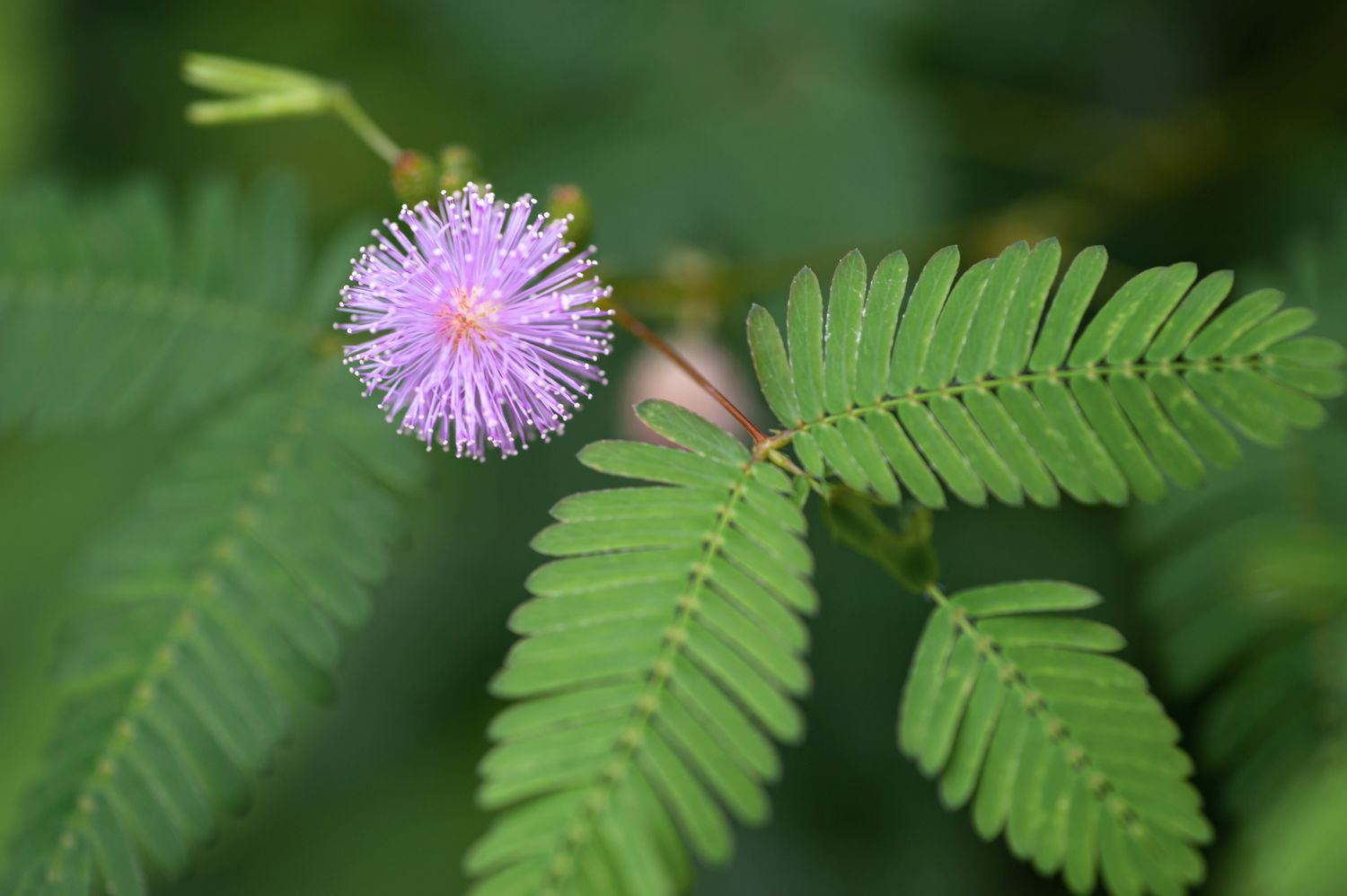
Mimosa pudica, also known as the sensitive plant or touch-me-not, is an intriguing and unique species of plant that captivates both botanists and nature enthusiasts alike. Famous for its responsive nature to touch, Mimosa pudica displays a fascinating series of movements when stimulated, making it a popular choice for those looking to add a touch of novelty to their gardens.
Aside from its intriguing behavior, Mimosa pudica has a rich history and is deeply rooted in traditional medicine. Native to Central and South America, this plant has been used for centuries by various cultures to treat a wide array of ailments.
In this article, we delve into the world of Mimosa pudica and explore 13 captivating facts about this remarkable plant that will leave you in awe of its remarkable adaptations and unique characteristics.
Key Takeaways:
- Mimosa pudica, also known as the Sensitive Plant, has fascinating leaf movements and colorful blooms. It’s used in traditional medicine and benefits the environment by improving soil quality and providing shelter for insects.
- While easy to grow and care for, Mimosa pudica can also be invasive in certain regions due to its adaptable nature and high seed production. Its unique abilities make it a captivating addition to any garden or indoor space.
The Sensitive Plant
Mimosa pudica, commonly known as the Sensitive Plant, is a fascinating species of plant that belongs to the pea family. It gets its name from its unique ability to fold its leaves inwards and droop when touched or exposed to external stimuli, such as heat or vibration.
Natural Defense Mechanism
The leaf folding response of Mimosa pudica serves as a defense mechanism against herbivores. By drooping their leaves, the plant can deter potential threats and protect itself from being eaten.
Native to South and Central America
Mimosa pudica is indigenous to tropical regions of South and Central America, where it grows as a tender perennial. It thrives in warm and humid climates, but can also be found in other parts of the world as an introduced or cultivated species.
Curious Leaf Movements
Not only does Mimosa pudica respond to touch, but it also exhibits nyctinastic movements, meaning its leaves fold together during nighttime or in response to changes in light intensity. This behavior is controlled by the plant’s circadian rhythm.
Pink and Purple Blooms
When in bloom, Mimosa pudica produces small, ball-shaped pink or purple flowers. These attractive blossoms are clustered together and add a vibrant touch to the plant’s appearance.
Medicinal Uses
Mimosa pudica has a long history of being used in traditional medicine. In various cultures, it is believed to possess beneficial properties and has been used to treat conditions such as diarrhea, dysentery, skin infections, and even depression.
Environmental Benefits
The presence of Mimosa pudica in an ecosystem can have positive effects on the environment. It helps improve soil quality by fixing nitrogen, prevents soil erosion with its widespread root system, and provides shelter and food for insects and other small creatures.
A Popular Ornamental Plant
Due to its unique leaf movements and colorful blooms, Mimosa pudica is a sought-after plant for gardens and indoor spaces. It adds an element of intrigue and delight to any floral display.
Seeds Are Highly Adaptive
Mimosa pudica produces small, long-lasting seeds that have a high adaptability for dispersal. They can survive harsh conditions and remain dormant until they find a suitable environment for growth.
Climbing Abilities
Although Mimosa pudica is generally a low-growing plant, it can sometimes exhibit climbing behavior with the help of tendrils. This allows it to reach higher levels and take advantage of available sunlight.
Cultivation and Care
Mimosa pudica is relatively easy to grow and care for. It requires well-draining soil, moderate watering, and a sunny location. However, it is important to avoid overwatering, as excessive moisture can lead to root rot.
Other Common Names
Aside from “Sensitive Plant” and “Mimosa pudica,” this intriguing species is also known by various other names, including “Touch-Me-Not,” “Shameplant,” “Humble Plant,” and “Sleeping Grass.
Ecological Invasiveness
In certain regions, Mimosa pudica has become an invasive species, rapidly spreading and outcompeting native plants. Its adaptable nature, high seed production, and ability to self-fertilize contribute to its success in colonizing new areas.
Conclusion
In conclusion, Mimosa pudica, also known as the sensitive plant or touch-me-not, is a truly fascinating plant. Its unique ability to close its leaves in response to touch and various stimuli has captured the attention and curiosity of people around the world. Not only does it exhibit this intriguing behavior, but it also possesses several other remarkable characteristics and uses.From its medicinal properties to its role in environmental conservation, Mimosa pudica offers a wealth of benefits and surprises. Whether it’s attracting pollinators or serving as a natural fertilizer, this plant plays an important role in maintaining ecological balance. Its ability to thrive in diverse conditions and adapt to different environments adds to its allure.So, the next time you come across a Mimosa pudica, take a moment to appreciate its captivating nature and the wonders it holds. From its delicate leaves to its surprising responses, this plant is a testament to the beauty and complexity of the natural world.
FAQs
1. Why is Mimosa pudica called the sensitive plant?
Mimosa pudica is called the sensitive plant because of its unique ability to close its leaves in response to touch or various stimuli. This reflex action is a defense mechanism to protect itself from potential harm.
2. Can I grow Mimosa pudica indoors?
Yes, Mimosa pudica can be grown indoors as it adapts well to potted environments. Ensure it receives adequate sunlight, water, and proper care to thrive.
3. Is Mimosa pudica an invasive species?
Mimosa pudica can sometimes be considered invasive in certain regions, particularly in tropical areas. It is important to monitor its growth and prevent it from spreading uncontrollably.
4. Does Mimosa pudica have any medicinal properties?
Yes, Mimosa pudica has been traditionally used in herbal medicine for various purposes. It is believed to have anti-inflammatory, antimicrobial, and analgesic properties. However, it is always recommended to consult a healthcare professional before using any plant for medicinal purposes.
5. How can I propagate Mimosa pudica?
Mimosa pudica can be propagated through its seeds or by taking stem cuttings. Seeds should be soaked in water for a few hours before sowing, while stem cuttings should be planted in a well-draining potting mix.
6. Can I touch the leaves of Mimosa pudica?
Yes, you can touch the leaves of Mimosa pudica. Its unique leaf-closing response provides an interactive and intriguing experience for observers. However, it is always important to handle plants with care and to avoid excessive touching or damaging the leaves.
7. Is Mimosa pudica toxic to pets?
Mimosa pudica is considered non-toxic to pets. However, it is always a good idea to monitor your pets around plants and consult with a veterinarian if you have any concerns.
Mimosa pudica's captivating qualities make this sensitive plant truly remarkable. Its rapid leaf movements and defensive strategies showcase nature's ingenuity. Beyond its mesmerizing abilities, Mimosa pudica boasts medicinal properties and environmental benefits. As you've learned about this fascinating species, why not explore more intriguing facts about sensitive plants? Uncover the secrets behind their unique adaptations and how they thrive in various habitats. Delving deeper into the world of sensitive plants will reveal even more astonishing details that will leave you in awe of these incredible botanical wonders.
Was this page helpful?
Our commitment to delivering trustworthy and engaging content is at the heart of what we do. Each fact on our site is contributed by real users like you, bringing a wealth of diverse insights and information. To ensure the highest standards of accuracy and reliability, our dedicated editors meticulously review each submission. This process guarantees that the facts we share are not only fascinating but also credible. Trust in our commitment to quality and authenticity as you explore and learn with us.


